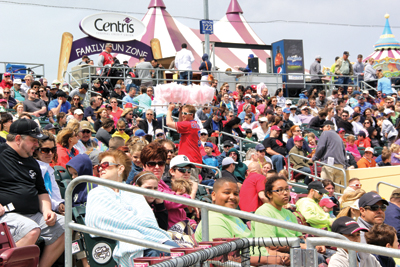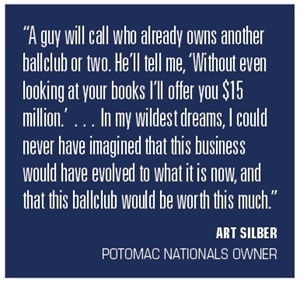You’d think if someone said, ‘I’m the owner of a minor league team,’ they’d have a pretty good idea of how to run it so it made money,” Michael Savit was saying. “That wasn’t the case.”
Not so long ago, minor league baseball teams in most regions of the country were available for a song, often less than $1 million. In some cases, they were acquired for nothing more than the willingness to pull the prior owner out of a hole. “It was a common theme back then,” said Pat O’Conner, a 31-year veteran of Minor League Baseball who has served as its president since 2007. “You needed eight teams to have a league. ‘Take the eighth for assumption of debts.’”
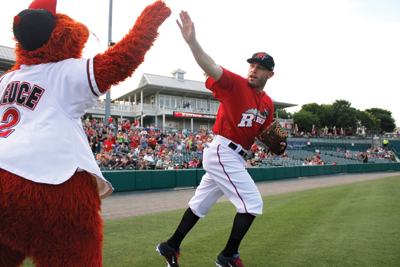 |
|
In June, the Frisco RoughRiders sold for $32 million, a minor league record price that was topped less than a month later.
Photo by: FRISCO ROUGHRIDERS
|
Many teams played before a few hundred fans a night, in outmoded ballparks with few revenue streams. Some were barely solvent, in large measure because they were being run as hobbies. No wonder valuations were depressed.
“My only regret was that I didn’t get involved earlier,” said Savit, a former IMG executive who bought his first franchise in 1997. “In those days, if you wanted a franchise, they’d pretty much just say, ‘Go ahead.’”
The Dayton Dragons emerged from one of those situations. From 1988 through 1999, they suited up as the Rockford Expos, the Rockford Royals, the Rockford Cubbies and the Rockford Reds, drawing around 1,000 fans a game. In 2000, Mandalay Sports Entertainment, the investment fund founded by movie producer Peter Guber, bought the team and took it from Illinois to a new stadium in Dayton, Ohio, within commuting distance of the parent-club Cincinnati Reds.
The Dragons haven’t played before an unsold seat since.
Last month, Savit’s HWS Group paid $40 million to Mandalay for the Midwest League’s Dragons. The purchase price was a record for a minor league affiliate — and it only bought Savit a Class A franchise — but the transaction didn’t happen in a vacuum.
For more than a decade, smart shoppers have been buying up teams, often clubs with negative balance sheets. “Either it’s a market issue, or stadium, or operations,” said Stuart Katzoff, whose Manhattan Capital Sports Acquisition fund owns teams in Reno, Nev., and Bowling Green, Ky., and is hunting for more. These operators increase their teams’ cash flow — and their value — with better operations, enhanced facilities, and professional marketing and sponsorship. They’re perfectly willing to move them to a distant state if they can get someone there to build a new ballpark.
The resulting rise in valuations has been dizzying.
The Class AAA Tucson team that Katzoff purchased in 2006 for $15 million was playing in a city where “it’s 116 degrees in the summer and rains at 4 every afternoon, and there are 30 days of spring training right before the season,” he said. He relocated the team to a gleaming new facility in Reno. “Reno was the redefinition of the AAA market,” O’Conner said. If sold today, the Aces would probably fetch $30 million.
Dubious? Just months before Savit’s group bought Dayton, Mandalay sold its Class AA Frisco (Texas) team to former Texas Rangers CEO Chuck Greenberg for $32 million. Earlier this year, a group led by multiple franchise owner Ken Young bought the Class AA Huntsville (Ala.) Stars for $16 million.
The Stars, who play in a 30-year-old stadium, are heading for Biloxi, Miss., and a $36 million facility that is being built by the city and state on land provided by a local casino.
“By the time we put this team in a new ballpark, the value of the franchise should have accrued 30 to 35 percent,” Young said.
“People call about San Antonio,” said Dave Elmore, who owns the Class AA franchise there, as well as six other Minor League Baseball teams. “The first thing they say is, ‘Look, I know it’s going to be at least $25 million.’”
Art Silber, who spent about $500,000 in 1990 to buy the Class A team in Prince William County, Va., that is now the Potomac Nationals, said he gets offers regularly. “A guy will call who already owns another ballclub or two,” Silber said. “He’ll tell me, ‘Without even looking at your books I’ll offer you $15 million.’ I was a highly trained financial analyst, but in my wildest dreams, I could never have imagined that this business would have evolved to what it is now, and that this ballclub would be worth this much.”
Asked if he finds the offers enticing, Silber shook his head. In 2017, he’ll move the team to a self-financed ballpark in what he calls a “perfect location,” alongside I-95 in Woodbridge, Va.
“Right now, we have the worst ballpark in the league and one that probably ranks in the bottom 10 of organized baseball’s 160,” he said. “At the new ballpark, the visibility will be extraordinary. Naming rights alone will pay for a lot of the stadium.”
He can only imagine what the team will be worth.
Taken together, Minor League Baseball’s numbers are startling. Some 40 million Americans (and a few Canadians) went to a game last year. That’s more in total attendance than what the NBA, NHL or NFL can tout.
The games themselves are ostensibly the same as MLB’s, merely a few notches below. But as a business, this is a vastly different enterprise, as removed from the majors as college basketball is from the NBA.
“What keeps fans coming back,” said Bradley Reynolds, general manager of the Southern League’s Mobile (Ala.) BayBears, “isn’t baseball. If they want a better baseball game, they can see it on ESPN. This is about affordability, family fun, wholesome entertainment. That’s what makes this business unique and what makes it work.”
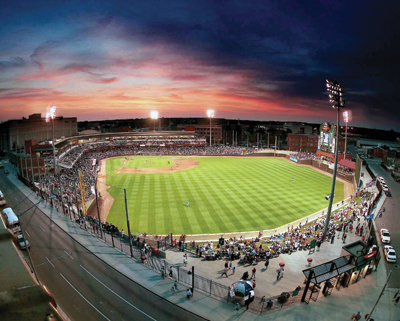 |
|
The Dayton Dragons, which sold for $40 million in July, boast a sellout streak that began in 2000 when the team moved into its new stadium.
Photo by: DAYTON DRAGONS
|
Some minor league teams compete against major league sports, as in Nashville, New Orleans and Indianapolis. Elsewhere, towns such as Burlington, Iowa, support teams that serve as the sole manifestation of community pride. Some markets have downtown ballparks and storied baseball heritages. Others have facilities in exurbs and far-flung subdivisions where little else happens. A few fortunate teams are affiliated with nearby big league franchises. Others are as detached, physically and psychologically, as the Pulaski (Va.) Mariners are from their parent club in Seattle.
But there are common factors driving the valuation surge. The old generation of mom-and-pop ownership is dying off, or selling. That has created opportunity. “A lot of minor league baseball was owned by groups of local investors who were having fun and not really paying much attention,” Katzoff said.
Katzoff’s fund, which he runs with his father, Jerry, isn’t much different from Mandalay, which has owned or run eight different franchises since 2000 and is currently divesting. (Note to potential investors: Erie and Oklahoma City still remain.) “Peter Guber was ahead of his time,” Katzoff said. “He accumulated a bunch of teams … and sold out to Seaport Capital. They had a fund life, and the fund ended. But it had its run.”
Katzoff’s group has no time horizon. It plans to distribute returns as it goes. “So after five or seven years, you get all your money back and you’re sitting on an asset,” he said. “And this happens to be a very good business if you purchase the team right and operate it right. These are profitable teams, not hobbies.”
The opportunity for profit comes because costs are low. Parent clubs supply the players, whom they can promote, trade or release with impunity. That makes marketing personalities, or even competitive success, almost impossible, but it also means that player salaries aren’t an expense. And with many of the ballparks built to lure teams from other cities, rents are low or even nonexistent.
That’s the expense side. Revenue consists of ticket sales, suites and club seats for the increasing number of teams that have them, and finding local and national companies to put their names on as many different aspects of the game and parts of the stadium as possible. Those ceremonial first-pitches, fan-participation contests, between-innings promotions, and sing-alongs that are so much a part of the minor league experience exist primarily as sponsorship inventory.
These days, too, branded items — from game-worn jerseys to beer mugs, sold at the stadium and online — are an increasingly relevant profit center. If your nickname is unique and proprietary, like Flying Squirrels, Isotopes, Lake Monsters, Sea Dogs, Sand Gnats or Biscuits, so much the better.
“There was a day — and you’ve heard it a million times — that the way to make a small fortune in baseball was to start with a big one,” O’Conner said. “That’s not the case anymore. These teams are not only gaining in valuation, but most are holding their own.”
Some minor league teams have cash flow into the seven figures, O’Conner notes. Only a third of teams are losing money, and in most cases, the losses are negligible. “If your day job is to work the market, you can do better than in baseball,” he said. “But if you want a real safe place to park your money, that’s where we come in as a very attractive alternative.”
It isn’t just potential profits driving these sales. “They’re not based on the normal economic model of how you value a business,” Savit said. “For whatever reason — and I’m very happy about this — people don’t value these teams like they would any other business in their community.”
Sports teams are a perk of wealth in American culture, a bauble for successful businessmen. With the cost of a major league team into nine figures (or more), the minors have become the way for mini-moguls to get the kick of owning controlling interest.
“Part of the reason that valuations are high is vanity,” Elmore said. “People are willing to accept 3 percent to 5 percent return on their money if they can say they own a team.”
Until MLB expands, something not on the horizon, the number of affiliates across the 17 leagues will remain static. The market consists of what’s there now, and nothing more — unless you count the independent leagues, which operate without fail-safes against franchises taking on excess debt or playing in substandard facilities. Independents also pay their own player salaries.
To O’Conner, a signal event in the growth of Minor League Baseball — following the 1988 movie “Bull Durham,” which put the sport in the American consciousness for a new generation — was the dot-com boom and subsequent bust. “All of a sudden, there was a lot of money sitting on the side, looking for somewhere to go,” he said. The same happened in 2008, when capital was pulled out of the stock market. Wealthy businessmen with more than enough savings to live on were suddenly out of that game — and looking for a new one.
Gary Green, a 49-year-old building services provider based in New York, is the model of the modern franchise owner. In 2009, he bought a Class AA team in Norwich, Conn., and moved it to Richmond, Va. “I have my core business, which I’ve worked hard at,” he said. “That has allowed me to fulfill my dream of owning a baseball team.”
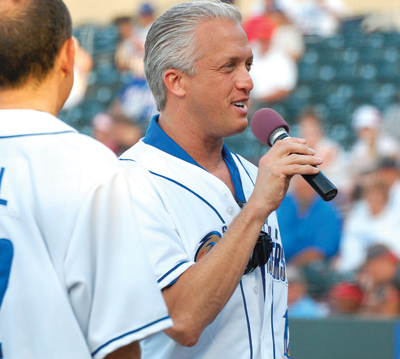 |
|
Gary Green (above) paid more than $15 million for the Omaha (Neb.) Storm Chasers. The team will draw roughly a half million fans this season.
Photos by: OMAHA STORM CHASERS (2)
|
Two years ago, buoyed by his success in Richmond, he paid more than $15 million for the Omaha (Neb.) Storm Chasers, who’d been owned, in part, by Warren Buffett. Like the Dayton Dragons, that team was no tear-down. It had already moved from Rosenblatt Stadium to an intimate, single-decked, suburban facility that has plenty of suites and a club sponsored by Jim Beam, and changed its name from the Royals to the more marketable Storm Chasers. Almost overnight, souvenir sales tripled. “Crucially,” said Martie Cordaro, Omaha’s general manager, “we control our own revenues: parking and concessions and naming rights and everything else.”
One Saturday evening recently, Green’s Storm Chasers were playing the El Paso Chihuahuas. In many places around Werner Park, you’d never have known it. The kids in the 7,500-square-foot Centris Family Fun Zone in left field, or riding the Universal Studios carousel, might have been at an amusement park. The 20-somethings in a foosball game at the Budweiser Downdraught Bar, or sipping the team’s proprietary Ale Storm beer (available in stores starting this summer), could have been whiling away time at a pub.
Big league games are so expensive you’d better spend your time watching baseball. But in the minors, a $6 ticket can be perceived as the cover charge to a bar, or the cost of entry to access an entertainment arcade. “We need to always be doing something different, giving people new reasons to come to the ballpark,” Green said.
The Storm Chasers will turn a profit this year, as they have annually since 2007, and draw roughly half a million fans. “That’s one-sixth of what the Dodgers will draw, but we’re not worth one-sixth of what the Dodgers are worth,” Green notes. “The difference in value is in the broadcast contract. That’s where the next shift will come from. There’s a great demand to see these young prospects who have almost mythical qualities. Better broadcast quality will help us fill that demand, and profit from it.”
That has started to happen. In 2008, the minor leagues’ governing body created the Baseball Internet Rights Co. as a way to standardize Internet content across all the affiliated teams. Beyond free websites for teams, that includes live streaming of minor league games. If you’re a fantasy baseball owner who wants to scout prospects, or you’re just a hard-core fan of a big league team who’s eager to see the young players in the pipeline, you have far more access than ever before.
“BIRCO is going to be a leader for us in virtually every aspect of our business: e-commerce, exposure, everything else,” O’Conner said. “Right now, we’re limited to 160 communities. With BIRCO, we’re only limited by AC/DC power and an Internet connection. It opens up our universe.”
Once an owner learns how to run his team at a profit, keeping expenditures low and finding incremental new income, it becomes clear that the formula will work elsewhere. There’s no direct economy of scale in owning more than one team, no additional purchasing power or reduced labor costs. But there’s an intellectual economy of scale at play.
“The names change and communities change,” said Reynolds, who runs Mobile for Savit. “But once you have the confidence in the model, it’s fairly easy to replicate it from city to city.”
“Most cities, Tuesday nights are dead,” said Elmore. He was edging his way through a crowd of 8,500 in Colorado Springs on a Tuesday in May: a sellout despite a downpour that delayed play for half an hour. By combining group sales, Tuesday night season tickets and discounts, he said, the Sky Sox “get to 8,000 week after week.”
Elmore’s teams are well-run and invariably successful, both off and on the field. Last year, three won championships in their leagues, and Colorado Springs, Idaho Falls and Eugene have earned various business awards, including the John H. Johnson President’s Award for Eugene’s Emeralds. Four or five times a year, the general managers and other executives of Elmore’s teams (and several more owned by his sons) gather to share insights.
Elmore bought his first team, the old Hawaii Islanders, in 1981, for $1 million. He moved it to Colorado Springs in 1988. The market is the second-smallest in Class AAA, but the franchise has rolled along, making money while accruing value. “You can put up with low earnings if you don’t have to service debt,” Elmore said.
In a ramshackle facility that poorly serves its suburban Washington, D.C., market, one of the most affluent in baseball, Art Silber has been doing just that for years. Silber was CEO of Baltimore’s Sterling Bank & Trust in 1988 when he helped friends finance the purchase of a team in Frederick, Md. After helping fund “maybe a dozen” franchises for friends, Silber landed one of his own. Silber invested $300,000 and borrowed a bit more. “People convinced me it was something I should do, and it didn’t take a lot of convincing,” he said.
Today, he’s sitting on an asset worth … $20 million? $25 million? His proposed $70 million stadium, which will be built on land donated by the municipality, will change that. “We’re counting on 200,000 to 300,000 in annual attendance,” he said. “But we actually think we can hit 400,000.” It’s a figure that would have annually exceeded that of several big league teams when Silber was growing up in Brooklyn, but it wouldn’t rank his club in the minors’ top 10 today.
Silber has retired to Florida. His daughter, an MBA with a banking background, runs the team with little regard for what happens on the field. “I’m not a sports person,” Lani Weiss admitted. “I’m a woman running a family business that happens to be a baseball team.” She’s in the office every day, making executive decisions and poring over the finances. But she often doesn’t stay for the game.
Many of today’s owners can’t visit their teams every week, or even every month. They hire general managers to run them and pass through when they can.
On a recent evening, one such absentee owner stepped on a plane in San Diego, headed for a Class A game in Visalia, Calif. Over the past decade, Tom Seidler has resurrected a once-thriving baseball market that had fallen on hard times. He’s no dot-com millionaire or construction magnate but a baseball lifer born into the sport. His grandfather, Walter O’Malley, owned the Dodgers.
Growing up, Seidler parked cars at Dodger Stadium. He served an internship for Great Falls, Mont., in the Pioneer League, and later returned to run that team. When the O’Malleys sold the Dodgers to News Corp. in 1998, he and Peter O’Malley’s son, Kevin, looked to keep the family in the sport on a smaller scale.
“Baseball had been in Visalia since the 1940s,” Seidler said, sitting in an air-conditioned lounge at Rawhide Ballpark, home of the team now known as the Visalia Rawhide but known for many years as the Visalia Oaks. “Yet when we got here, we never saw Oaks T-shirts or hats, or posters in windows. It was like the team didn’t exist.”
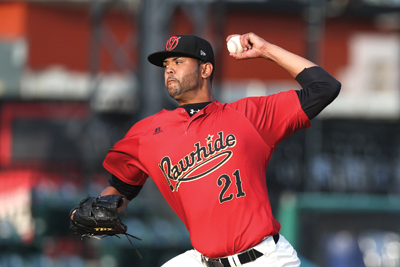 |
|
The Visalia (Calif.) Rawhide found renewed community support following a change in ownership.
Photo by: AP IMAGES
|
Rather than move it, Seidler persevered. He visited ballparks around the country. Some of the features he saw were incorporated in an $8.8 million upgrade that the city ultimately agreed to finance.
Visalia is in California’s Central Valley, but it has a Midwestern tenor. It’s less than an hour from the San Francisco Giants’ top farm club in Fresno, but you get the sense that few Rawhide fans have made the trip. The team is rooted in the community.
The contrast could hardly be more striking with the other team that Seidler’s family owns. In 2012, Peter O’Malley headed a group that purchased the Padres. Seidler moved to San Diego to help run his uncle’s franchise. Now he shuttles between major and minor league baseball like a marginal prospect, watching Albert Pujols and Yasiel Puig pass through Petco Park one night and greeting old friends in the stands during a Rawhide-High Desert Mavericks game the next.
Visalia isn’t even a Padres affiliate; it’s a Class A outpost of the Arizona Diamondbacks. There’s no grand scheme, no plan to dovetail the investments under the same player-development umbrella. Nevertheless, Seidler perseveres. Outsiders can’t quite understand why. “Someone covering a major league team for a newspaper doesn’t keep stringing for a paper in a minor league city,” O’Conner said with a laugh.
Then he explained it. “This is an entirely different model than the majors,” he said. “At any minor league game, half the people leave without even knowing which team won or lost. But what they do know, what surveys show that 98 percent know, is that they’ve had a hell of a good time — and that they’re coming back. We sell the sizzle. It’s a whole different business.”
Bruce Schoenfeld is a writer in Colorado and a frequent contributor to SportsBusiness Journal.




